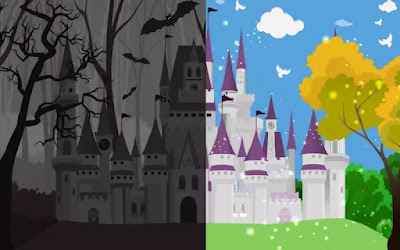Fairy tales are often thought of as innocent stories meant for children's entertainment. However, they contain dark and scary elements that serve a purpose in shaping the audience's worldview. In this article, we will explore the deeper meanings of fairy tales and their significance beyond mere entertainment.
Fairy tales are a genre of stories that typically involve magical creatures, enchanted objects, and supernatural events. They have been passed down through generations and adapted by different cultures, making them a universal part of our collective storytelling tradition.
But contrary to popular belief, fairy tales were not originally intended for children. They were told by adults to other adults as cautionary tales, often with violent and gruesome details. It was not until the 19th century that fairy tales were adapted to be more child-friendly. Even then, they retained their darker elements, which we will explore in this article.
Thesis Statement: Fairy tales are not just innocent stories, but they contain dark and scary elements that have a purpose in shaping the audience's worldview.
In the following sections, we will examine the historical context of fairy tales, analyze the psychological aspects of their dark and scary elements, explore their cultural and social commentary, discuss feminist interpretations of their portrayal of women, analyze the literary techniques used in fairy tales, and examine modern examples of fairy tales in popular culture.
So, let's dive deeper into the world of fairy tales and uncover their hidden meanings.
I. Historical Context
Fairy tales have a long history that dates back centuries. They were originally oral tales told by storytellers to entertain adults in their communities. These stories were not intended for children, and their content was often violent, sexually explicit, and full of social commentary. It was only in the 19th century that fairy tales began to be adapted for children.
The adaptation of fairy tales for children can be traced back to the work of the Brothers Grimm. In 1812, they published their first collection of fairy tales, which included stories like Cinderella, Hansel and Gretel, and Little Red Riding Hood. These stories were a huge success, and the Brothers Grimm continued to publish more collections of fairy tales over the years.
However, the original versions of the stories were deemed too violent and gruesome for children. In the 19th century, the notion of childhood as an innocent and protected time of life began to emerge. As a result, many fairy tales were edited and censored to remove the more disturbing elements and make them more suitable for children.
The most famous example of this is the story of Little Red Riding Hood. In the original version of the story, the wolf eats the little girl, and the story ends there. In the edited version, the woodcutter comes to her rescue and cuts open the wolf's belly, freeing the girl and her grandmother. This happy ending was added to make the story less frightening for children.
Other fairy tales were also modified to suit the tastes of a young audience. For example, the stepsisters in Cinderella were punished for their cruelty to the heroine, rather than being mutilated or killed as they were in the original story.
Despite these changes, fairy tales continued to be popular with children and adults alike. In fact, they were often used as a way to teach children moral lessons and social norms. For example, the story of The Three Little Pigs teaches children the value of hard work and perseverance, while The Ugly Duckling teaches them about acceptance and self-worth.
II. Psychological analysis
Fairy tales have always contained dark and scary elements, and many people wonder why they are so popular with children. Psychologists have suggested that these stories provide a safe space for children to explore and understand complex emotions. By presenting children with scary situations and allowing them to see the heroes and heroines overcome their fears and triumph, fairy tales give children a sense of mastery and control over their own fears and anxieties.
Moreover, fairy tales offer children a way to learn about the world around them. They present the dangers and challenges that children may face in their lives and offer strategies for dealing with them. For example, the story of Little Red Riding Hood teaches children about the dangers of talking to strangers, while the story of Hansel and Gretel teaches children about the importance of resourcefulness and perseverance.
III. Cultural and social commentary
Fairy tales also reflect the cultural and social norms of the time in which they were written. They offer insight into the values and beliefs of the society that produced them. For example, the story of Cinderella reflects the importance of marriage and social status in 17th century France, where the story originated. The character of the Fairy Godmother can be seen as a symbol of the power of the aristocracy to transform the lives of the poor.
Moreover, fairy tales have been used as a way to challenge the social norms of their time. In the story of Little Red Riding Hood, for example, the heroine is a young girl who outwits the wolf and saves herself and her grandmother. This was a radical departure from the traditional portrayal of women in fairy tales, who were often passive and helpless.
IV. Feminist interpretation
The portrayal of women in fairy tales has long been a topic of debate. Feminist scholars have argued that fairy tales often reinforce gender stereotypes and promote the idea of the damsel in distress who needs to be rescued by a prince. However, feminist writers have also used fairy tales as a way to subvert these stereotypes and create more empowering narratives for women.
One example of this is the story of The Paper Bag Princess by Robert Munsch. In this story, the princess rescues the prince from a dragon and then decides that she does not want to marry him after all. The story challenges traditional gender roles and promotes the idea of female empowerment and independence.
V. Literary analysis
Fairy tales are not just stories for children, but they are also important works of literature that have influenced the development of the horror and gothic genres. Fairy tales use a range of literary techniques to create suspense and terror, such as the use of foreshadowing, repetition, and the supernatural.
The supernatural elements in fairy tales are particularly important. They provide a way for the stories to transcend the boundaries of reality and to explore deeper themes and emotions. For example, the fairy godmother in Cinderella represents the power of magic to transform the lives of the oppressed.
VI. Contemporary examples
Fairy tales continue to be popular today, and they are often adapted and reimagined for modern audiences. Many movies and TV shows are based on fairy tales, such as Disney's Snow White and the Seven Dwarfs and the popular TV series Once Upon a Time.
These modern retellings often adapt and subvert traditional elements of the stories to create new and exciting narratives. For example, the TV series Grimm portrays fairy tale characters as real people living in modern-day Portland, Oregon. The show explores the darker and scarier aspects of the original stories and uses them to create a compelling and suspenseful drama.
👉 Read more posts with the same topic
VII. Conclusion
In conclusion, fairy tales are not just innocent stories but contain dark and scary elements that serve a purpose in shaping our worldview. As we have explored in this article, fairy tales have a rich history and have undergone many transformations over time to become the stories we know today.
From a psychological perspective, fairy tales provide a safe space for children to explore complex emotions and help them deal with their fears and anxieties. The dark and scary elements in these stories serve a purpose in preparing children for the challenges they may face in life.
Fairy tales also reflect the cultural and social norms of the time in which they were written, and they offer a unique lens through which we can analyze the values and beliefs of a society. Feminist interpretations have also shed light on the ways in which fairy tales perpetuate gender stereotypes and how feminist writers and scholars have reimagined these stories to create more empowering narratives.
As literary works, fairy tales employ a variety of techniques to create suspense and terror. These stories have also influenced modern horror and gothic literature, and they continue to be relevant today in popular culture through retellings in movies, TV shows, and other forms of media.
In summary, fairy tales are not just children's stories but are a rich and complex form of literature that has much to offer readers of all ages. By examining the historical, psychological, cultural, feminist, and literary aspects of fairy tales, we can gain a deeper understanding of their enduring significance in shaping our worldview. Fairy tales provide us with a lens through which we can explore our fears, hopes, and dreams, and they offer a unique perspective on the human experience that continues to captivate and inspire us.









0 Comments